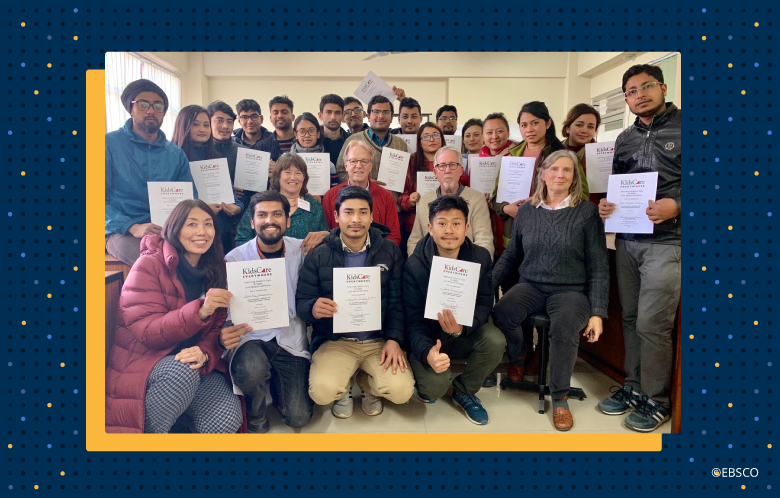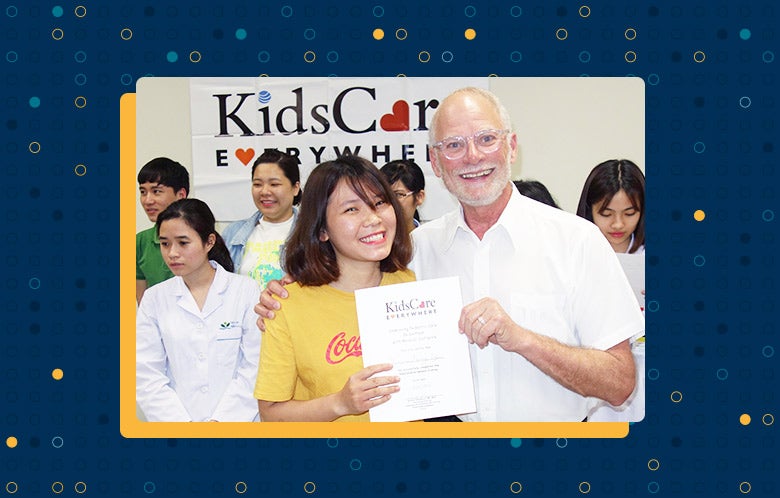Like for most of us, the last two years have been challenging for KidsCareEverywhere (KCE). Seeing global partners work tirelessly to treat an insurmountable number of COVID patients, in often broken hospitals and health systems, is heartbreaking. KCE adapted during the pandemic, switching from an in-person model of software training to a virtual model. Virtual meetings, while imperfect, have allowed KCE to continue trainings and refresh DynaMed® software. KCE has now provided current software to all KCE-trained physicians in Ghana, India, Peru, Nepal and Vietnam. In many locations, DynaMed continues to be the primary source of medical information for physicians. Now, as global vaccinations for COVID continue to rise and many countries approach herd immunity, KCE is thrilled to again begin planning on-the-ground trainings, now planned in the second half of 2022. Our first stop — Peru.
In 2016, KCE began a collaboration with Universidad Peruana Cayetano Heredia, a medical school in the capital city of Lima. We worked closely with the school’s then dean, Patricia Garcia, who moved on to become Peru’s Minister of Health. Since KCE’s original trip to Peru, the excitement around point-of-care health care training has only grown — KCE has visited five hospitals in Lima and three in the southern city of Ica. Introducing DynaMed into Peru’s health care system has had a significant effect on access to evidence-based clinical knowledge —Peru clinicians are consistently the most active current users with whom we collaborate.
In honor of KCE’s upcoming 2022 trip, we are sharing the experience of former KCE global health fellow, now emergency medicine physician, Elaine Yang, MD, on her trip to deliver and train physicians at Hospital Nacional Dos de Mayo in Lima, Peru, in 2018.

Doctors at Hospital Nacional del Dos De Mayo from the 2018 KCE training.
New Doors Open for KCE in Lima, Peru
There was a certain air of excitement as the KidsCareEverywhere team walked through the historic gates of Hospital Nacional del Dos de Mayo in Lima, Peru, on the first day of software training. Although I was not part of the original team that brought the medical reference center PEMSoft here in 2016, I could feel an exuberant warmth and congeniality as staff greeted us in the administrative offices on our first day. As this year’s global health fellow, I had the opportunity to introduce something new to familiar faces — DynaMed, a mobile application that incorporates PEMSoft’s on-demand pediatric clinical decision tools an evidence-based clinical decision support tool covering adult clinical care. On this visit, we would not only be reaching pediatricians, but also supporting providers caring for patients of all ages by giving them a handheld medical library.
What struck me immediately about Hospital Nacional Dos de Mayo is its history steeped in public service and medical education including a mausoleum that houses the remains of an honored medical student, Daniel A. Carrion, who died in 1885. Carrion is considered a national hero. He injected himself with contents from the wart of a patient with a common warty illness to study the disease’s natural history and establish the link between the chronic form and its initial deadly febrile course. Carrion died as a result of his experiment, and infection with Bartonella bacilliformis now carries his name. The disease, also known as Oroya fever or verruga peruana, is endemic to the region and often fatal in the acute phase if left untreated. Thinking of the advances in scientific research and the summation of medical knowledge since Carrion’s time is truly mind-boggling and further underscores modern medicine’s need for facile, searchable clinical databases to deliver the best patient care.
Having the tool at his fingertips not only allows him to answer clinical questions during moments of decision-making, but also opens opportunities for further research and advancement of patient care.
Having the tool at his fingertips not only allows him to answer clinical questions during moments of decision-making, but also opens opportunities for further research and advancement of patient care.
This visit to Lima opened new doors for KCE. Despite some initial hiccups in publicizing our arrival, we quickly learned that word spreads like wildfire here and we were soon being asked to present DynaMed and its features at other hospitals. In addition to training physicians at Dos de Mayo, we trained medical personnel at el Hospital Nacional Arzobispo Loayza, el Instituto Nacional de Salud del Niño (the nation’s single quaternary pediatric referral center), and Peru’s future physicians studying medicine at la Universidad Nacional Mayor de San Marcos. This diverse group of attendings, residents, medical students, and nurses from services spanning Neonatology to Geriatrics were not only impressed with the tool’s ease of access to the most current guidelines and recommendations, but also excited about the direct links to primary sources for further reading and investigation.
The highlight of each training session was fielding clinical questions to demonstrate the search function of the tool. The “search and find” from each problem raised led to a wealth of information. An internist’s dilemma in managing a patient whose self-treatment of genital warts with trichloroacetic acid had gone too far prompted a discussion on chemical burns and appropriate wound dressings, including consideration of silver impregnated agents since the patient’s wound appeared quite deep. A resident whose patient had cytomegalovirus infection and kidney dysfunction was able to quickly find the therapeutic renally-adjusted dose for intravenous ganciclovir. A hematologist was thrilled to discover a body surface area-based dosing calculator for methotrexate, and how simple it was to bookmark this page for her frequent use.

Elaine Yang, right, with a doctor from Hospital Nacional del Dos De Mayo at the 2018 KCE training.
On a return visit to el Hospital Nacional Arzobispo Loayza, a second-year resident in Geriatric Medicine was delighted to tell me that he had been using DynaMed in the week since we last met. In his practice, he cares for hospitalized elderly patients, many of whom have become bedbound after a fall, fracture or progressive frailty. He used the tool to read up on prevention of sarcopenia and pressure ulcers for these patients. Using the Norton scale calculator, easily found in the Calculators section of the mobile app, he assessed a patient’s risk for developing pressure ulcers and modified his plan of care accordingly. What he enjoys most is the fact that DynaMed acts as a diving board to delve further into the literature on geriatric dysmobility, which has become a particular area of interest for him. Having the tool at his fingertips not only allows him to answer clinical questions during moments of decision-making, but also opens opportunities for further research and advancement of patient care. In this way, KCE continues to brighten the future and influence medical care across generations throughout Lima.
Subscribe to EBSCO Health Notes to follow KCE on their journey to deliver software and train doctors around the globe.


